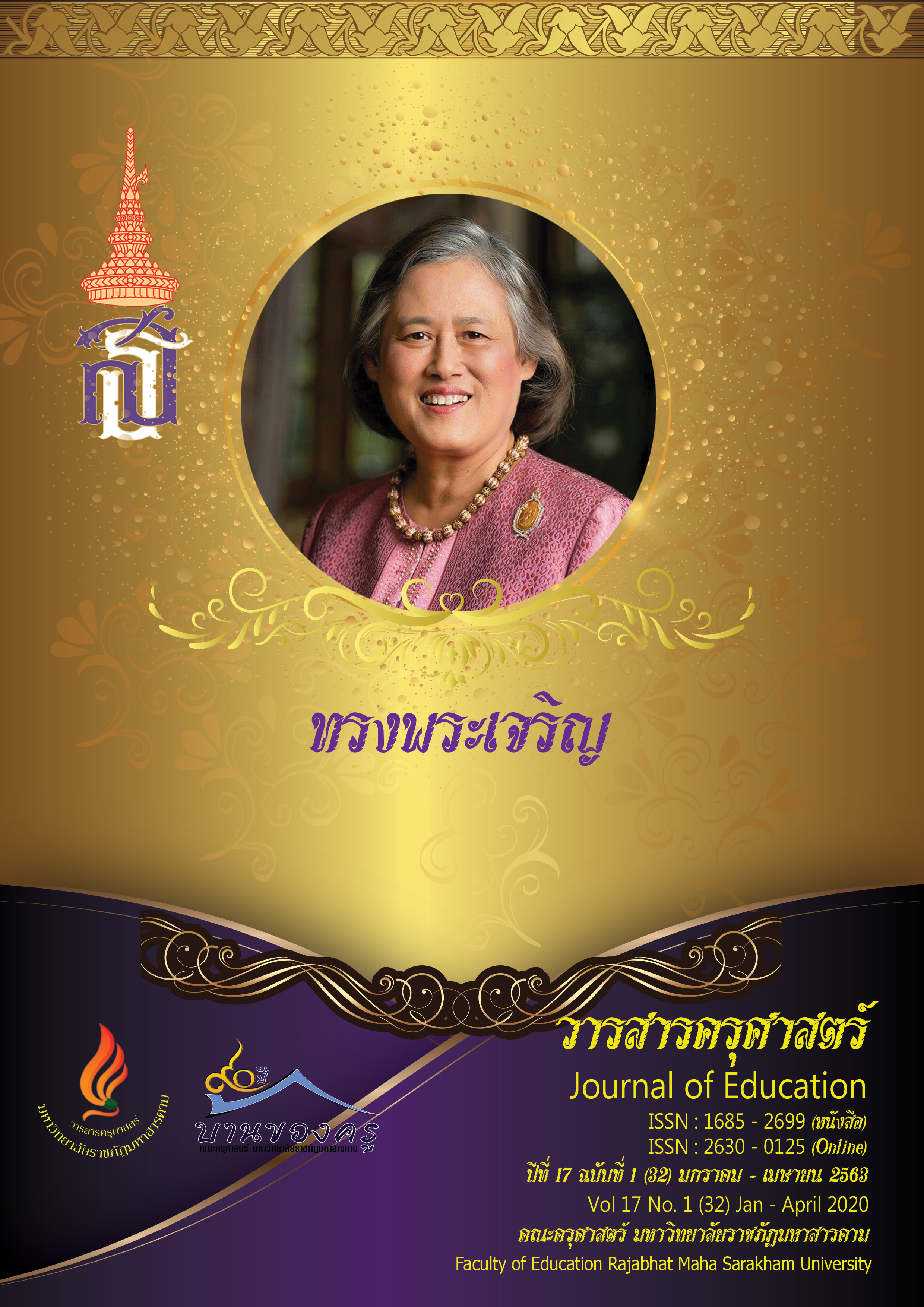Development of Active Learning with accountability Model to Enhance Mathematical Problem Solving Skills of 9th Graders
Main Article Content
Abstract
The purposes of this research were to: 1. study the circumstances of mathematics teaching
and learning management, 2) construct and develop of active learning with accountability model
and 3) try out development of active learning with accountability model to enhance mathematical
problem solving skills of 9th grade. The related samples and target groups consisted of 175
mathematics teachers teaching in the lower secondary schools under the Office of the Secondary
Educational Service Area Office 29, 4 advisory level teachers in teaching mathematics in the lower
secondary schools, 7 experts and 5 students. The research instruments were (1) active learning with
accountability model, (2) test and (3) satisfactional questionnaires. The statistics used to analyze the
data were frequency, percentage, mean, standard deviation, t-test independent, two-way ANOVA,
correlation analysis and multiple regression analysis.
The research revealed that 1) The experiment students learning by active learning with
accountability model had higher responsibilities significantly than the students in the controlled
group at .01, 2) The experiment students learning by active learning with accountability model had
higher significantly than the controlled group students at. 01 and 3) The active learning with
accountability method affected positively to the mathematics problem solving skills at the
significance of. 01.
Article Details
ข้อกำหนดเบื้องต้นที่ผู้นิพนธ์(ผู้ส่งบทความ) ควรทราบ
1. ผู้นิพนธ์ที่ประสงค์จะลงตีพิมพ์บทความกับวารสาร ตั้งแต่เดือนมกราคม 2563 เป็นต้นไป ให้ใช้รูปแบบใหม่ (Template 2563) โดยสามารถดูตัวอย่างได้ที่เมนู GUIDELINES
2. จะตีพิมพ์และเผยแพร่ได้ ต้องผ่านการประเมินจากผู้ทรงคุณวุฒิ (Peer Review)
3. การประเมินบทความโดยผู้ทรงคุณวุฒิ (Peer Review) เป็นแบบ Double Blind
4. การอ้างอิงบทความใช้หลักเกณฑ์ APA (American Psychological Association) คลิก
5. บทความถูกปฏิเสธการตีพิมพ์ ไม่ผ่านการประเมิน ผู้นิพนธ์ขอยกเลิกเองหรือชำระเงินก่อนได้รับการอนุมัติ ทางวารสารไม่มีนโยบายการคืนเงิน
References
กันยา พลายมี. (2553). การพัฒนาแบบวัดความรับผิดชอบ ตามพระบรมราโชวาทของพระบาทสมเด็จพระเจ้าอยู่หัวสำหรับนักเรียนชั้นประถมศึกษาปีที่ 4 สำนักงานเขตพื้นที่การศึกษาสุพรรณบุรี (วิทยานิพนธ์ปริญญาครุศาสตร์มหาบัณฑิต). มหาวิทยาลัยราชภัฏกาญจนบุรี, กาญจนบุรี.
บุญชม ศรีสะอาด. (2541). การพัฒนาการสอน (พิมพ์ครั้งที่ 2). กรุงเทพมหานคร: ชมรมเด็ก.
ปริญญา พวงจันทร์. (2556). การศึกษาความคิดสร้างสรรค์ในการทำโครงงานเรื่อง ความสัมพันธ์ระหว่างราชอาณาจักรไทยกับสาธารณรัฐอินโดนีเซียของนักเรียนชั้นมัธยมศึกษาปีที่ 6 ด้วยการเรียนรู้แบบโครงงานสำหรับโรงเรียนคูพั่ฒนาไทย-อินโดนีเซีย (วิทยานิพนธป์ ริญญาศึกษาศาสตรมหาบัณฑิต). มหาวิทยาลัยศิลปากร, นครปฐม.
ปิยนาถ เหมวิเศษ. (2551). การสร้างกิจกรรมการเรียนการสอนคณิตศาสตร์ที่เลือกใช้กลยุทธ์ในการแก้ปัญหาที่หลากหลายเพื่อเสริมสร้างความสามารถในการแก้ปัญหาทางคณิตศาสตร์ สำหรับนักเรียนชั้นมัธยมศึกษาปีที่ 3 (วิทยานิพนธ์ปริญญานิพนธ์การศึกษามหาบัณฑิต). มหาวิทยาลัยศรีนครินทรวิโรฒ, กรุงเทพมหานคร.
พิสมัย อาแพงพันธ์. (2557). การพัฒนารูปแบบการสอนคณิตศสตร์ตามแนวคิดอิงการเรียนรู้อิงบริบท (วิทยานิพนธ์ปริญญาปรัชญาดุษฎีบัณฑิต). มหาวิทยาลัยราชภัฏสกลนคร, สกลนคร.
ไพศาล เครือแสง. (2558). รูปแบบการส่งเสริมจริยธรรมทางการบริหารตามหลักธรรมาภิบาลของผู้นำองค์กรปกครองส่วนท้องถิ่นในเขตภาคเหนือตอนล่าง. วารสาร มจร สังคมศาสตร์ปริทรรศน์, 4(1), 205-220.
รัฐศาสตร์ พนคุณวุฒิ. (2553). การจัดกิจกรรมการเรียนการสอนคณิตศาสตร์ที่เชื่อมโยงกับสถานการณ์ในชีวิตจริงเรื่อง การวัดสำหรับนักเรียนชั้นมัธยมศึกษาปีที่ 2 โรงเรียนแกน้อยศึกษา จังหวัดเชียงใหม่ (วิทยานิพนธ์ปริญญาศึกษาศาสตร์มหาบัณฑิต). มหาวิทยาลัยเชียงใหม่, เชียงใหม่.
ศราวุฒิ ขันคำหมื่น. (2553). การประยุกต์ใช้รูปแบบการเรียนรู้เชิงรุกวิชาฟิสิกส์ เรื่อง สภาพสมดุลสำหรับนักเรียนมัธยมศึกษา (วิทยานิพนธ์ปริญญาวิทยาศาสตรมหาบัณฑิต). มหาวิทยาลัยเทคโนโลยีพระจอมเกล้าธนบุรี,กรุงเทพหมานคร.
สถาบันส่งเสริมการสอนวิทยาศาสตร์และเทคโนโลยี. (2546). คู่มือวัดผลประเมินผลคณิตศาสตร์. กรุงเทพมหานคร:สถาบันส่งเสริมการสอนวิทยาศาสตร์และเทคโนโลยี.
สำนักงานคณะกรรมการการศึกษาขั้นพื้นฐาน. (2556). แผนปฏิบัติการประจำปีงบประมาณ พ.ศ. 2557.กรุงเทพมหานคร: สำนักงานคณะกรรมการการศึกษาขั้นพื้นฐาน กระทรวงศึกษาธิการ.
สิทธิพร อาจอินทร์. (2554). การพัฒนารูปแบบการจัดการเรียนรู้ที่เน้นการคิดวิเคราะห์กลุ่มสาระการเรียนรู้วิทยาศาสตร์. วารสารวิจัย มข, 16(1), 72-82.
สิริรัตน์ บุตรสิงห์. (2551). การเปรียบเทียบผลสัมฤทธิ์ทางการเรียนและความรับผิดชอบต่อการเรียนวิชาสังคมศึกษาของนักเรียนชั้นประถมศึกษาปีที่ 6 ที่ได้รับการสอนโดยการเรียนแบบร่วมมือด้วยวิธีจิกซอร์ 2 กับการสอนตามปกติ (วิทยานิพนธ์ปริญญาครุศาสตรมหาบัณฑิต). มหาวิทยาลัยนครสวรรค์, นครสวรรค์.
สุนิสา แก้วกระจ่าง. (2553). การศึกษาความสามารถในการแก้ปัญหา เรื่อง เส้นขนานของนักเรียนชั้นมัธยมศึกษาปีที่ 2 ที่ได้รับการจัดการเรียนรู้โดยใช้ชุดกิจกรรมกระบวนการกลุ่มสัมพันธ์ (วิทยานิพนธ์ปริญญาการศึกษามหาบัณฑิต). มหาวิทยาลัยศรีนครินทรวิโรฒ, กรุงเทพมหานคร.
Bonwell, C. C., and Sutherland, T. E. (1996). Using active learning in college class : A range of option for faculty. San Fransico: Jossey-Bass.
Brandes, D., and Ginis, P. (1996). Aguide to student-centered learning. Oxford: Blackwell.
John, M. (2011). QBQ!: The Question Behind The Question. New York: USA, G. P. Putnam’s Sons.
Krulik, S., and Reys, R. E. (1980). Problem solving in school mathematics. Reston, Virginia: NCTM.National Council of Teachers of Mathematics (NCTM). (1989). Curriculum and evaluation standard for school mathematics. Reston, Virginia: NCTM.
Sandford, F. H., and Wrightsman, L. S. Jr. (1970). Psychology. Belmont: Books/Cole.
Walberg, H. J. (1984). Improving the productivity of America’s schools. Educational leadership (Alexandria, VA), 41(8), 19–27.


